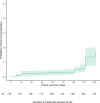Prevalence and incidence of anti-SARS-CoV-2 antibodies among healthcare workers in Belgian hospitals before vaccination: a prospective cohort study
- PMID: 34187832
- PMCID: PMC8245288
- DOI: 10.1136/bmjopen-2021-050824
Prevalence and incidence of anti-SARS-CoV-2 antibodies among healthcare workers in Belgian hospitals before vaccination: a prospective cohort study
Abstract
Objectives: To describe prevalence and incidence of anti-SARS-CoV-2 antibodies among Belgian hospital healthcare workers (HCW) in April-December 2020.
Design: Prospective cohort study. Follow-up was originally planned until September and later extended.
Setting: Multicentre study, 17 hospitals.
Participants: 50 HCW were randomly selected per hospital. HCW employed beyond the end of the study and whose profession involved contact with patients were eligible. 850 HCW entered the study in April-May 2020, 673 HCW (79%) attended the September visit and 308 (36%) the December visit.
Outcome measures: A semiquantitative ELISA was used to detect IgG against SARS-CoV-2 in serum (Euroimmun) at 10 time points. In seropositive samples, neutralising antibodies were measured using a virus neutralisation test. Real-time reverse transcription PCR (RT-qPCR) was performed to detect SARS-CoV-2 on nasopharyngeal swabs. Participant characteristics and the presence of symptoms were collected via an online questionnaire.
Results: Among all participants, 80% were women, 60% nurses and 21% physicians. Median age was 40 years. The seroprevalence remained relatively stable from April (7.7% (95% CI: 4.8% to 12.1%) to September (8.2% (95% CI: 5.7% to 11.6%)) and increased thereafter, reaching 19.7% (95% CI: 12.0% to 30.6%) in December 2020. 76 of 778 initially seronegative participants seroconverted during the follow-up (incidence: 205/1000 person-years). Among all seropositive individuals, 118/148 (80%) had a positive neutralisation test, 83/147 (56%) presented or reported a positive RT-qPCR, and 130/147 (88%) reported COVID-19-compatible symptoms at least once. However, only 46/73 (63%) of the seroconverters presented COVID-19-compatible symptoms in the month prior to seroconversion.
Conclusions: The seroprevalence among hospital HCW was slightly higher than that of the general Belgian population but followed a similar evolution, suggesting that infection prevention and control measures were effective and should be strictly maintained. After two SARS-CoV-2 waves, 80% of HCW remained seronegative, justifying their prioritisation in the vaccination strategy.
Trial registration number: NCT04373889.
Keywords: COVID-19; epidemiology; immunology; infection control; public health.
© Author(s) (or their employer(s)) 2021. Re-use permitted under CC BY-NC. No commercial re-use. See rights and permissions. Published by BMJ.
Conflict of interest statement
Competing interests: None declared.
Figures



References
-
- World Health Organisation . COVID-19 Weekly epidemiological update, 2020. Available: https://www.who.int/publications/m/item/weekly-epidemiological-update-on... [Accessed May 2021].
-
- Karlsson U, Fraenkel CJ. Covid-19: risks to healthcare workers and their families. BMJ 2020;m3944. - PubMed
-
- World Health Organisation . Who SAGE roadmap for prioritizing the use of COVID-19 vaccines in the context of limited supply: an approach to inform planning and subsequent recommendations based upon epidemiologic setting and vaccine supply scenarios, November 2020. Available: https://cdn.who.int/media/docs/default-source/immunization/sage/covid/s... [Accessed 2021 May].
-
- Sciensano. Fact sheet - COVID-19 disease (SARS-CoV-2 virus), April 2021. Available: https://covid-19.sciensano.be/sites/default/files/Covid19/... [Accessed May 2021].
Publication types
MeSH terms
Associated data
LinkOut - more resources
Full Text Sources
Medical
Miscellaneous
